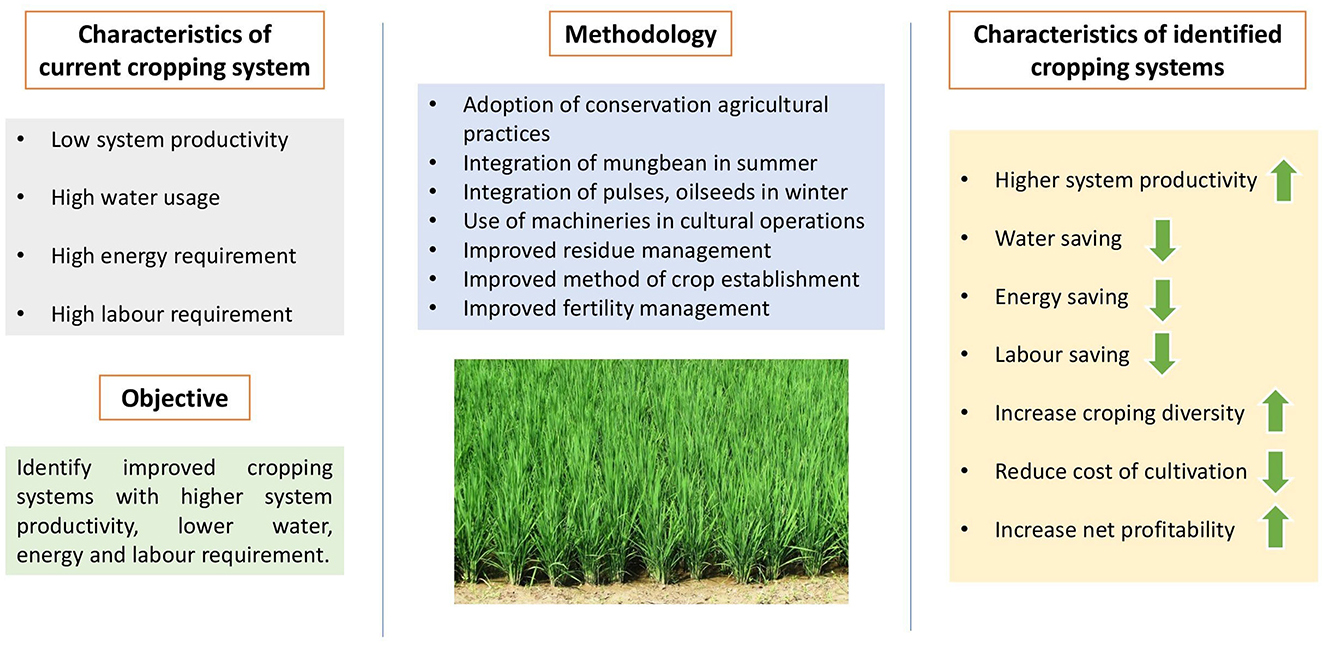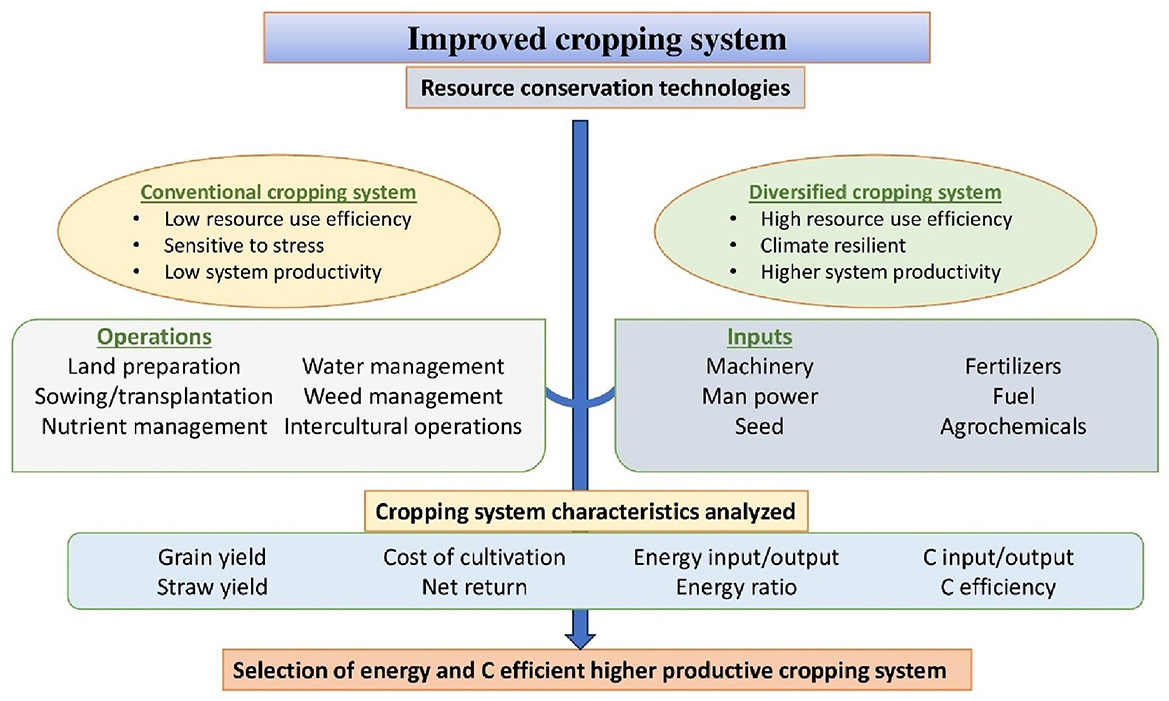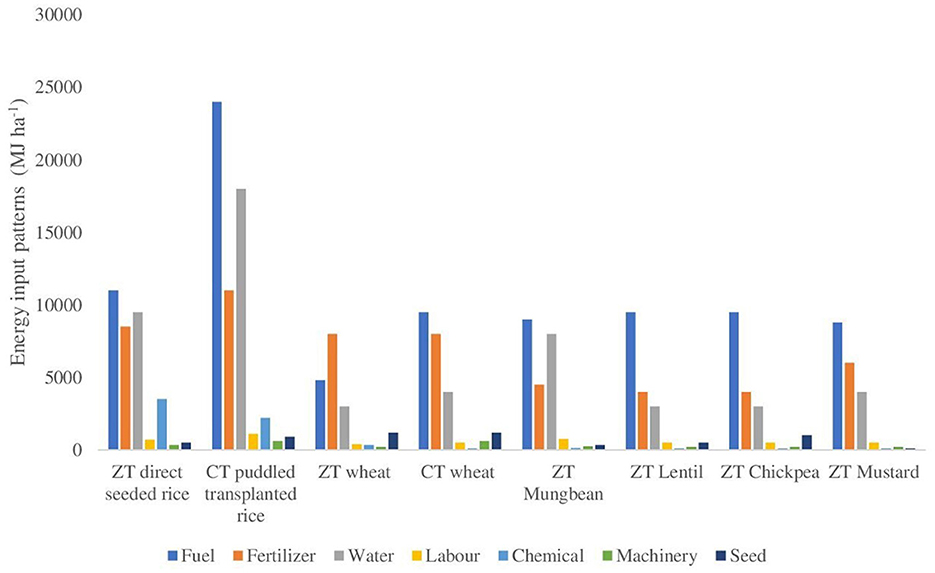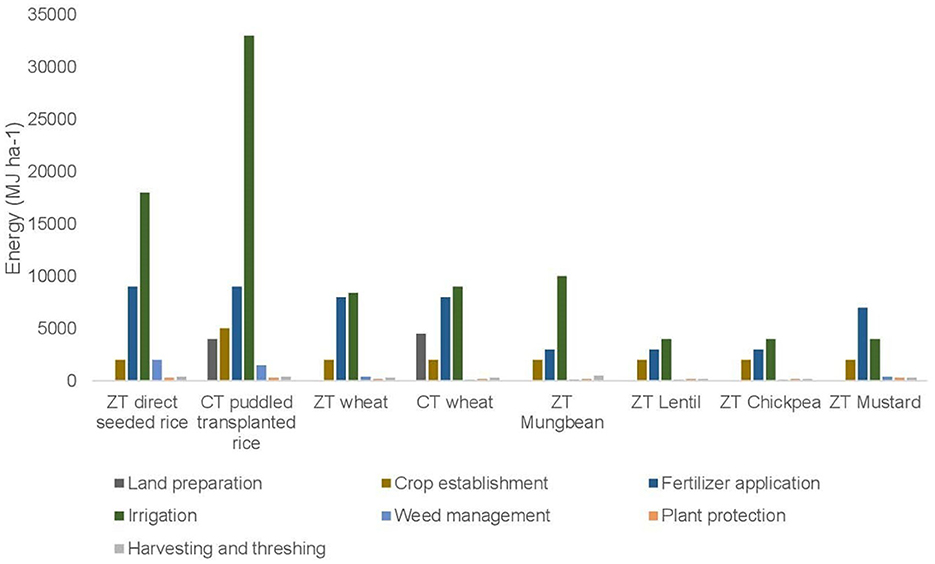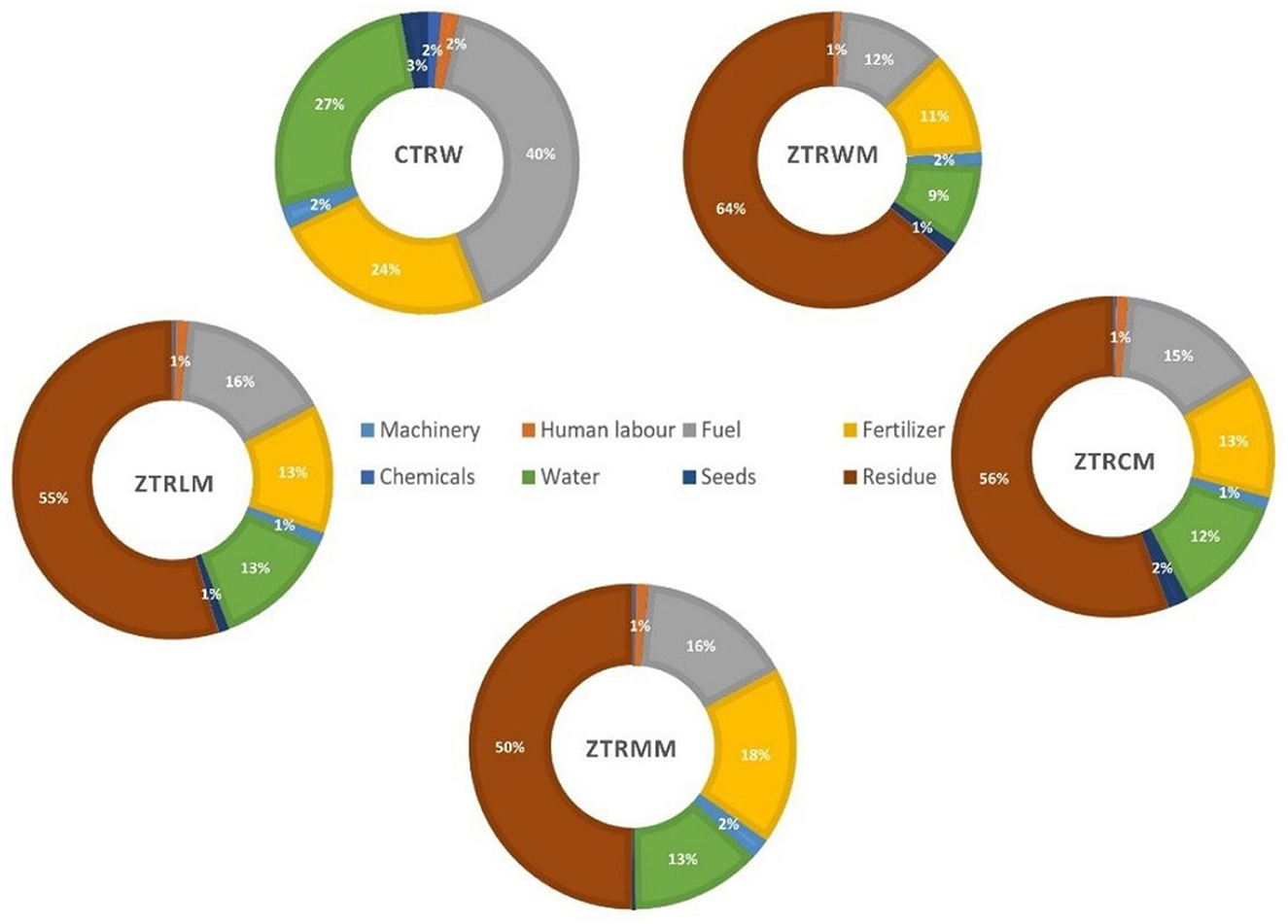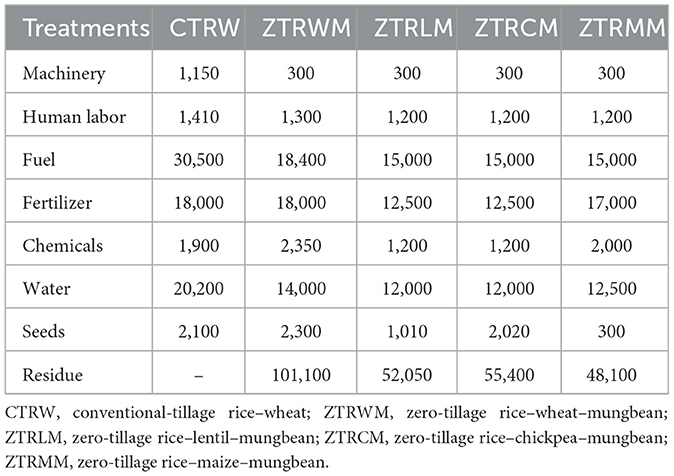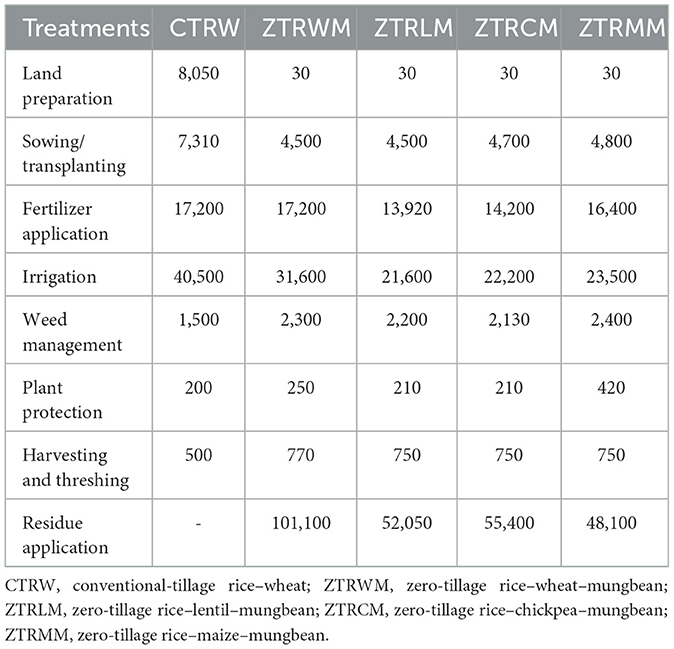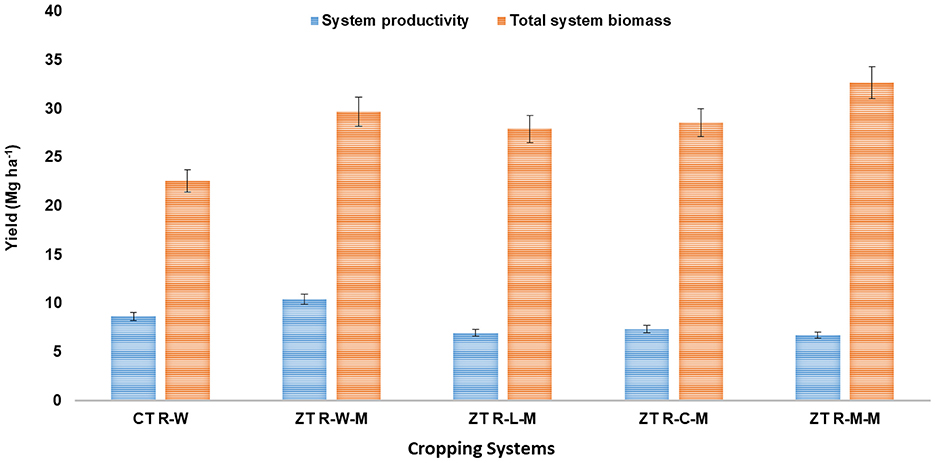- 1ICAR Research Complex for Eastern Region, Patna, Bihar, India
- 2ICAR Indian Agricultural Research Institute, Regional Station Pusa, Samastipur, Bihar, India
- 3Borlaug Institute of South Asia (BISA), Samastipur, Bihar, India
The most common cropping production system in South Asia, transplanted puddled rice followed by conventional-tillage wheat, is highly unsustainable, extremely energy-intensive, and emits a large amount of greenhouse gases. The practices used in conservation agriculture, including diversified cropping rotations, residue retention, zero-tillage direct-seeded rice, and zero-tillage wheat, can increase crop productivity while reducing energy use requirements and carbon footprints. Therefore, to promote a sustainable and energy-efficient conservation agriculture-based system with a less energy-intensive rice–wheat system, contrasting tillage and residue management scenarios were evaluated in this study. The treatments include triple cropping systems of zero-tillage direct-seeded rice (ZTDSR) during the rainy season, followed by zero-tillage rice–wheat–mungbean (ZTRWM) in winter, as well as zero-tillage rice–lentil–mungbean (ZTRLM), zero-tillage rice–chickpea–mungbean (ZTRCM), and zero-tillage rice–mungbean–mustard (ZTRMM) along with the conventional-tillage rice–wheat (CTRW) system. Zero-tillage systems exhibited significantly lower operational energy for irrigation (~40%), sowing (~26%), and land preparation (100%) compared to a conventional-tillage (CT) system. Compared to the conventional-tillage rice–wheat system, zero-tillage cropping systems achieved significantly higher system biomass yields. The zero-tillage system also increased wheat yields, resulting in a significant reduction in resources (fuel, fertilizer, and machinery) under zero-tillage (ZT) interventions. More than 60% of energy utilization came from crop residue, irrespective of the diverse cropping production systems. The maximum net energy returns, energy ratios, energy productivity, and energy intensity were recorded with the zero-tillage rice–wheat system. Zero-tillage production systems had significantly lower carbon footprints, higher carbon efficiency, and better carbon sustainability index than the conventional-tillage (CT) management system. Thus, it can be concluded that triple-zero-tillage production systems, along with residue management, yield lower net energy output, greenhouse gas emissions, and carbon footprints as compared to conventional-tillage-based systems.
Highlights
• This study evaluated the performance of conservation agriculture (CA)-based zero-tillage (ZT)-triple cropping production systems.
• ZT-based systems reduced energy inputs (48%), water (37%), and labor usage (13%).
• In ZT production system, crop residue was the key renewable energy source (60%).
• Triple ZT production systems improved the overall total biomass production (38%).
• ZT production systems reduced greenhouse gas (GHG) and carbon footprints (36%).
1 Introduction
Approximately 43% of the world's population depends on rice–wheat cropping systems for their food and livelihood security, with 27 Mha under cultivation worldwide (Dhanda et al., 2022). When assessing the sustainability of agricultural production systems, energy balance and greenhouse gas (GHG) emissions are the essential metrics, particularly in light of the resource degradation, climate change, and food poverty (Bohra and Kumar, 2015). To create an energy-efficient agrotechnology with minimal adverse environmental impacts, energy analysis aids in evaluating how agricultural production systems utilize energy and the connections between various energy inputs (Kumar et al., 2021a). The use of fertilizers and pesticides, irrigation, and enhanced mechanization has significantly increased energy consumption in agricultural production systems (Sarkar et al., 2024). About 18% of India's total GHG emission come from the agricultural sector, mainly from the burning of crop residue, conventional rice farming, livestock, and nitrogen fertilizer use (Gupta et al., 2021). India must focus on energy-efficient farming systems with a lower carbon footprint to provide food for the ever-growing population in the current scenario of resource limitations and climate change.
The most extensive agricultural production system in India is the rice–wheat cropping system (RWCS), which occupies over 12.3 Mha and accounts for 40% of the country's wheat area and 23% of its rice area (Singh et al., 2020a). While wheat grows on aerobic, finely tilled soils, rice is usually produced in flooded conditions with frequent tillage (Baghel et al., 2020). However, the conventional method of growing wheat and rice resulted in lower farm profitability, higher production costs, and decreased crop yields (Pratibha et al., 2015). Groundwater depletion, soil deterioration, salinity, and herbicide resistance are some of the issues facing this production system (Samal et al., 2017). Traditional rice/local cultivars and wheat tillage use a lot of energy, and fuel for tillage, planting, transplanting, and irrigation contributes significantly to the greenhouse gas (GHG) emissions (Ranaivoson et al., 2017). Specifically, methane emissions in agricultural production systems originate from the cultivation of conventional or transplanted puddled rice (TPR), and burning rice stubble contributes additional GHGs and pollutants (Arai, 2022).
To increase resource use efficiency and minimize environmental effects, conservation agriculture (CA)-based management practices place a strong emphasis on cropping rotations, regulated traffic, minimal soil disturbance, and soil cover (Mondal et al., 2020). Dry-direct seeded rice (DDSR), zero-tillage (ZT) wheat, and direct seeding with in situ residue management are some of the technologies developed for rice-wheat cropping systems under CA-based management production that contribute to energy conservation and a decrease in GHG emissions (Meena et al., 2015; Zahedi et al., 2015). For instance, zero-tillage direct-seeded rice (ZTDSR) significantly reduces methane (CH4) emissions while saving energy by requiring fewer irrigations, transplanting, and land preparations (Lal, 2004). Compared to traditional or conventional-tillage, zero-tillage (ZT) wheat saves ~3,000 MJ ha−1 and can reduce fuel usage by up to 60 L/ha (Kumar et al., 2021b). Crop residue recycling boosts soil health by providing nutrients and enhancing biological nutrient cycling, which improves water retention and reduces the irrigation needs (Dubey et al., 2024).
An important metric for evaluating the sustainability of modern crop production is the carbon footprint of agricultural operations during cropping, which expresses the environmental impact of GHG emission in terms of CO2 equivalents (Kumar et al., 2022a). Throughout crop production, lifecycle evaluations consider both direct and indirect emissions from inputs (Kumar et al., 2021b). It has been shown that CA-based management techniques, such as crop residue mulching, crop diversification, zero-tillage direct-seeded rice, and zero-tillage wheat, reduce carbon emissions and enhance the overall production system as well as carbon efficiency. Energy-efficient agricultural production systems with reduced carbon footprints are essential in the context of the energy crisis and climate change scenarios. Assessing sustainable agricultural production systems requires energy and carbon budgeting, which considers all energy and carbon inputs as well as outputs. Although crop productivity, resource use efficiency, and soil health have been main research topics in CA-based rice–wheat systems, little is known about energy linkages and carbon footprints. Furthermore, the majority of research has focused on specific crops and cropping systems, with various aspects of tillage and residue management.
The CA-based management paradigm (i.e., minimal soil movement, retaining crop residue cover on the soil surface, and use of diversified crop rotation) adopted by the farmers in South Asia has prompted scientists to revisit and provide solutions to many emerging challenges (Mishra et al., 2020). The CA-based management practices and cropping systems followed elsewhere are more diverse than those adopted in the Eastern Indo-Gangetic plains (EIGP). While puddling and transplanting are common in rice, zero tillage (ZT) with or without crop residue retention is practiced in subsequent winter crops, indicating that CA protocols are only partially adopted in the EIGP.
Therefore, sustainable intensification of rice–wheat cropping system (RWCS) using resource conservation technologies (RCTs) is urgently needed to meet growing food demands while protecting ecosystem services and environmental quality (Keil et al., 2019; Kumar et al., 2021c). The inclusion of summer green gram after wheat has emerged as an alternative to intensify and diversify RWCS, leading to increased system productivity, profitability, nutritional security, and improved soil health. The majority of the studies in EIGP have focused on zero-tillage based on a single crop in rice–wheat cropping systems. No attempt has been made to evaluate the effects of tillage, crop establishment method, and residue management on system productivity, energy use, and environmental footprint in triple-zero-tillage production systems. Hence, the present study was undertaken to identify the most suitable tillage and crop establishment practices to improve the overall productivity of the rice–wheat system. In addition to biological parameters, some important CA-based parameters, such as energy use and its contribution to global warming, as well as the efficient use of energy through RCTs, can help reduce the environmental footprints. We hypothesized that CA-based tillage and crop establishment methods would improve crop yields, system productivity, energy efficiency, and reduce environmental footprints. The results of this study will provide policymakers in nations with comparable agricultural production systems with variable insights, offering important direction and encouraging low-carbon, energy-efficient, and sustainable rice–wheat cropping systems in the Indo-Gangetic Plains and other similar agroecoregions worldwide.
2 Materials and methods
2.1 Location and climate
A long-term field experiment was conducted from 2019–2020 to 2023–2024 at Krishi Vigyan Kendra, Lalganj, Buxar, Bihar, India (25°32′47′′N, 83°059′28′′E) (Supplementary Figure S1). The experimental site is located in a tropical climate, characterized by the hot summers in May and June and mild winters during December and January (Supplementary Figure S2). The monsoon season (June to September) brings heavy rainfall, with the majority of precipitation occurring during this period only. The total mean annual rainfall recorded in 2023–2024 was 1,172 mm. The monthly mean rainfall and temperature (minimum and maximum) during the period 2020–2024 in Buxar, Bihar, India, are shown in Supplementary Figure S2. The experimental site had silty clay textured soil (sand 21%, silt 41%, and clay 38%), with a soil pH of 8.20 (1:2.5), Walkley–Black Carbon content of 6.2 g kg−1, and electrical conductivity of 0.49 dS m−1 at a soil depth of 0–15 cm. The available N, P2O5, and K2O content in the upper soil layers (0–15 cm soil depth) were 193, 27.6, and 236 kg ha−1, respectively.
2.2 Experimental details
A field experiment was conducted to assess the comparative resource use efficiency and production potential of rice-based conservation agriculture (CA) vs. conventional-tillage (CT) production systems. The experiment comprised five treatments with three replications, employing a randomized block design. CA-based management treatments included the triple zero-tillage production system: ZTDSR-ZT wheat-ZT mungbean (T1), ZTDSR-ZT lentil-ZT mungbean (T2), ZTDSR-ZT chickpea-ZT mungbean (T3), and ZTDSR-ZT mustard-ZT mungbean (T4). Additionally, conventional-tilled rice (transplanted puddled rice)-CT wheat (broadcasting) (T5) was included in the present study to provide a comprehensive comparison of the local farmers' practices with improved CA-based production systems. Each experimental plot was measuring 70 m × 10 m. In CA plots, rice, wheat (30%), and mungbean residue (full biomass after two or three harvests) were retained in fields according to the treatments. The varieties of rice, wheat, lentil, chickpea, mustard, and mungbean used in the experiment were Rajendra Sweta, HD 2967, IPL 120, GNG 2299, Pusa Mustard 30, and Virat, respectively (Supplementary Table S1). Sowing for ZTDSR and TPR nursery seeding was done during the second fortnight of June, and the crop was harvested in the last week of October. The winter crops (wheat, lentil, and chickpea) were sown in the 1st week of November, and harvesting took place in March. Zero-tillage mungbean was grown after harvesting the wheat crop (first fortnight of April) and harvested during the 2nd week of June. The detailed seed rates, spacing, and nutrient doses for respective crops are mentioned in Supplementary Table S1. A total of 10–12 irrigations (8–10 cm) were applied in the ZTDSR production system, while the conventional TPR crop received 18–20 irrigations (8–10 cm of the irrigation depth). In ZT and CT wheat, 6 irrigations (4–6 cm) were applied at different stages of crop growth. A presowing irrigation at a depth of 4–6 cm was applied in winter for better crop germination. Weed management was performed using glyphosate at 1.0 L a.i. ha−1 1 week before sowing to eliminate the existing weed flora. In the rice crop, weed control was achieved through a pre-emergence application of pendimethalin at 1.0 L a.i. ha−1, followed by a post-emergence application of bis-pyribac-sodium at 0.025 kg a.i. ha−1. Similarly, for wheat, weed control was performed through post-emergence application of met-sulfuron-methyl at 0.005 kg a.i. ha−1. In CA-based management practices, crop residue retains ~30% of the above-ground biomass of rice and wheat, along with the root biomass left in the field. A brief overview of the current long-term field experiment methodology is shown in Figure 1.
2.3 Crop yield and system biomass yield
Crop samples were manually harvested at crop maturity from a randomly selected area of 50 m2 (10 m × 5 m) for precise estimation of crop yields (grain and straw) (Kumar et al., 2020). After threshing and cleaning, grains were sun-dried and weighed to measure crop yields. Similarly, after harvesting, the yield of sun-dried straw and stover was recorded. The system biomass yield was calculated by adding the grain and stover yields of the respective crops used in the cropping system.
2.4 Energy calculation
A collection of inventories for different operations related to all crop inputs and outputs was created to carry out energy calculations. All inputs and outputs were converted into energy equivalents using various energy coefficients from several previous studies (Supplementary Table S2). The total energy input for various crops was determined by adding up all the individual input operations. Total energy input for various cropping systems was calculated by summing the energy used for each individual crop within those systems. The following equations were used to calculate the energy input for machinery (diesel and electricity), as adopted from Saad et al. (2016).
where Emp = energy of mechanical power per unit area (MJ ha−1), Wmp = weight of mechanical power (kg), Lmp = economic life of mechanical power (h), E = energy coefficient (MJ kg−1), and T = time consumed to cover 1.0 ha.
The average weights (Wmp), economic lifespan (Lmp), and time of operation (T) of different machines used for estimation of the mechanical energy (Emp) were taken from Singh et al. (2019).
Energy inputs were categorized based on their source and the type of farm operations. Furthermore, they were classified as direct and indirect energy as well as renewable and non-renewable energy sources (Chaudhary et al., 2017; Parihar et al., 2018). To obtain the total output energy of the crop, energy from grain and stover was integrated. Likewise, to calculate the system energy output, the energy output of individual crops was summed. The various energy indices were calculated using Equations 5–9 (Tuti et al., 2012).
2.5 Carbon emission
The global warming potential (GWP) in terms of carbon dioxide equivalent was calculated based on the emission factors (Supplementary Table S2) associated with agricultural inputs, including diesel, electricity, fertilizers, herbicides, and pesticides. Seasonal methane (for rice only) and nitrous oxide emission patterns for rice, winter crops (wheat, lentil, chickpea, and mustard), and green gram were estimated using emission factors. Methane is produced under anoxic conditions with a redox potential lower than −0.2 V. In our study, fields under wheat and green gram were never in an anaerobic condition, and the redox potential was much higher, making it unfavorable for methane emission (Jat et al., 2019). Moreover, no crop residue burning was performed in the field during the experimental period. Therefore, only CO2 and N2O are considered for measuring greenhouse gases in winter and spring crops (mungbean). However, in the case of rice, CH4, N2O, and CO2 emissions are included in the calculation. Methane emission factors were taken from the published literature and calculated based on our field inputs. The detailed emission factors are listed in Supplementary Table S2. The N2O estimation was calculated by multiplying the emission factor (0.01) by the quantity of N applied from all sources (fertilizers, residues) and converting it into N2O emitted by multiplying by 44/28. The formula is given as follows (Tubiello et al., 2015):
Global warming potential was calculated as per Babu et al. (2020):
2.6 Statistical analysis
The data collected from the present experimentation were statistically analyzed using a randomized block design via analysis of variance (ANOVA). Similarly, energy equivalent calculations for individual cropping sequences were performed using a randomized block design. The post hoc mean separation was conducted using Tukey's honest significant difference test (p ≤ 0.05) (Gomez and Gomez, 1984).
3 Results
3.1 Input energy usage pattern
Source-and operation-based energy input usage in different crops reveals that average total energy input under ZT-management practices was significantly lower compared to CT-based rice and wheat (Figures 2, 3). Fuel, water, and fertilizer were the significant sources of energy input under both ZT and CT interventions. The ZTDSR production system used 54, 47, 42, and 36% less energy from fuels, water, machinery, and labor compared to the conventional-tillage rice–wheat system (CTRW) production system. However, the ZTDSR system used 59% more energy through agrochemicals compared to the CTRW cropping system. Irrigation consumed the largest share of total energy in both the CTRW (62%) and ZTDSR (56%) production systems. ZTDSR production system could save 45 and 60% energy from irrigation and crop establishment methods, respectively, compared to CTRW cropping systems.
The ZT produced wheat consumed 22% lower total energy input as compared to CT wheat. Decreasing order of energy input as follows: fertilizer > fuel > water for ZT wheat, and fuel > fertilizer > water in case of CT wheat (Figure 2). In comparison to CT wheat, ZT produced wheat resulted in a decrease in fuel (49%) and machinery energy (67%). Operation-based wheat energy use revealed that, in ZT wheat, the main energy-consuming operations were irrigation (44%) and inorganic fertilizers (42%). Although under CT wheat, maximum energy spending operations were irrigation (37%), fertilizer application (33%), and land preparation (18%). To prepare land for crop sowing, CT wheat required an additional 4,500 MJ ha−1 of energy input. However, ZT produced wheat that used 300 MJ ha−1 more energy than CT wheat to manage weeds. Decreasing order of energy consumption share of input operations for ZT lentil, chickpea, and mustard was fuel > fertilizer > water, while for ZT mungbean was fuel > water > fertilizer (Figure 4). ZT intervention directly reduced input energy through eliminating land preparation. Operation-wise energy consumption showed that irrigation had the highest share of total input energy in ZT mungbean, lentil, and chickpea, whereas fertilizer application was the operation with the highest energy consumption under ZT mustard production (Figure 3). The primary sources of energy consumption in the CTRW cropping system were fuel (40%), water (26%), and fertilizer (24%) (Table 1). Crop residue (63%) accounted for the most significant portion of energy use in zero-tillage rice–wheat–mungbean (ZTRWM) with residue retention, followed by fuel (12%) and fertilizers (10%).
The ZT rice–wheat–mungbean cropping system consumed 40% less fuel energy compared with the CT rice–wheat system. Other ZT production systems had 51% lower energy spending for water use compared to the CTRW system. All ZT cropping systems follow similar trends in energy share, with crop residue contributing as the primary input utilization source, followed by fuel, fertilizer, and water. While in ZT rice–mustard–mungbean, input energy contribution followed trends of residue > fertilizer > fuel > water. Under all ZT cropping systems, residue retention remained the most significant component of total input energy, contributing ~60% of the total input energy utilization (Table 2). Conversely, irrigation (54%), followed by fertilizer application (23%) and land preparation (11%), were the primary energy sources under the CTRW system. Irrigation consumed the maximum input energy under CTRW system, which was 22, 46, 45, and 42% higher than ZTRWM, zero-tillage rice–lentil–mungbean (ZTRLM), zero-tillage rice–chickpea–mungbean (ZTRCM), and zero-tillage rice–mungbean–mustard (ZTRMM) cropping systems, respectively. The CTRW system used an additional 8,050 MJ ha−1 of energy to prepare the field and for sowing operation than ZTRWM cropping sequences. In contrast, ZT production systems using wheat, lentil, chickpea, and mustard consumed 53, 47, 42, and 60% more herbicide, respectively, than the rice–wheat system. The CTRW production system had higher fuel consumption than all ZT-based systems (Figure 4). The input energy of agronomic management practices distributed under various cropping systems is presented in Figure 5. Irrigation contributed the most significant energy input consumption under the CTRW production system, whereas, in ZT, residue retention was the major input energy source.
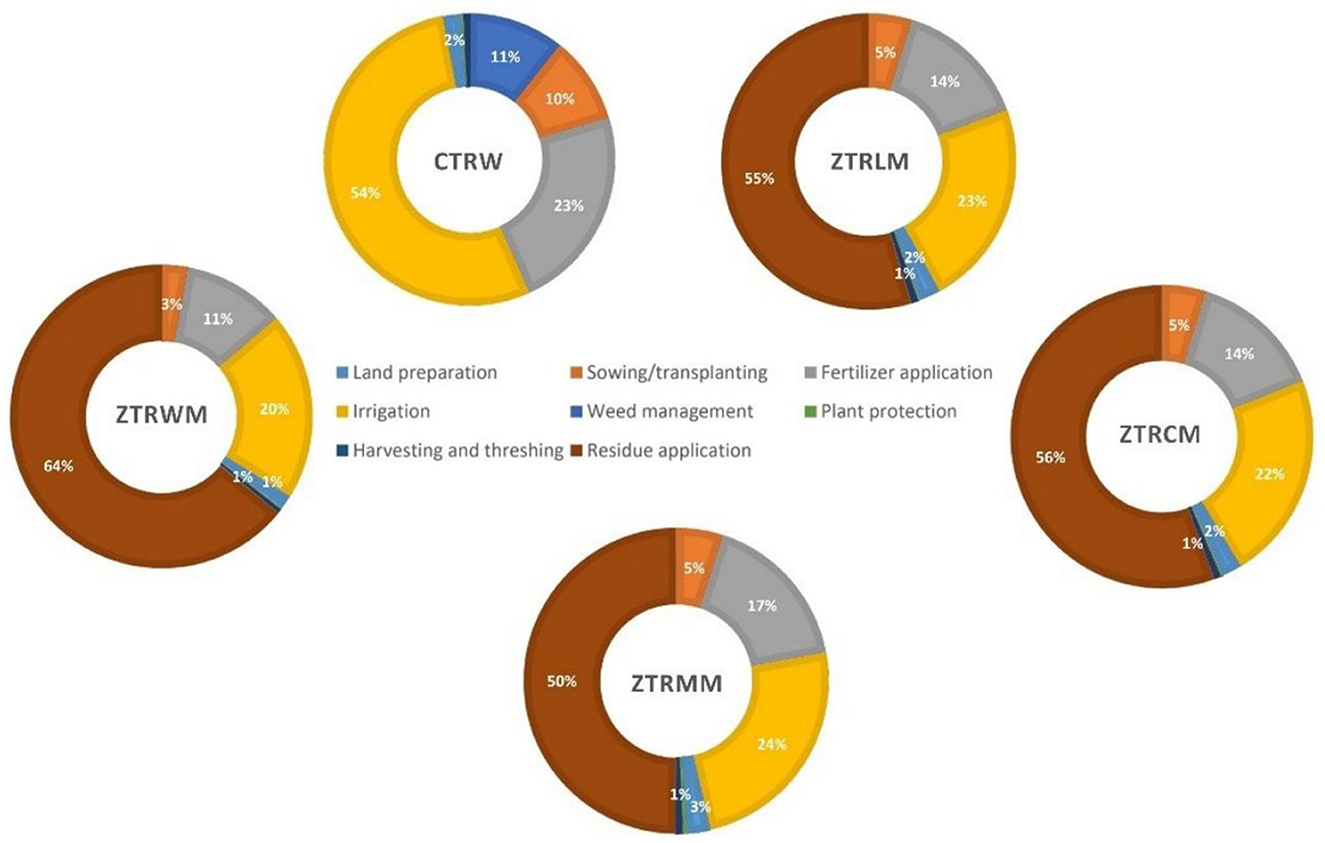
Figure 5. Distribution of input energy in different agronomic management practices under diverse cropping production systems.
3.2 Crop and biomass yields
Rice grain yield did not differ significantly among diverse cropping systems tested under the present experimentation (Figure 6). Similarly, grain yields of ZT systems did not significantly differ among themselves. However, ZT produced wheat (4.82 Mg ha−1), which had a significantly higher grain yield than CT wheat (4.42 Mg ha−1). The ZTRWM production system yielded the highest grain yield (8.64 Mg ha−1) and biomass yield (22.97 Mg ha−1) compared to other cropping systems. However, the lowest grain yield was recorded in ZTRMM (5.92 Mg ha−1). The lowest biomass production was recorded in the CTRW production system (22.6 Mg ha−1). Conservation tillage management practices and the addition of summer mungbean to the existing cropping system increased total biomass production by 38%.
3.3 Input–output energy relationship
Total energy input was substantially higher in the ZT production system compared to the CT production system (Table 3). The lowest energy input was recorded in the CTRW production system, which was 110, 32, and 28% lower, respectively, than those of the ZTRWM, ZTRCM, and ZTRMM production systems. The maximum energy output was recorded in ZTRWM, which was 17% higher than that of the CTRW production system. Net energy returns were the highest in CTRW, which was 22, 20, 12, and 6% higher than those in mustard-, chickpea-, lentil-, and wheat-based ZT-cropping systems. The CTRWM production system registered the highest energy ratio (4.98), which was 43, 39, and 37% higher than the wheat-, mustard-, and lentil-based ZT production systems, respectively. Similarly, the energy productivity (1.15 kg MJ−1) of the CT-based system was significantly higher than that of ZT-based cropping systems. Significantly higher energy intensity was noted in the CTRW cropping sequence, while the lowest value was observed with the ZTRWC system.
3.4 Greenhouse gas emissions and carbon footprint
The data on GHG emission revealed that fertilizer was the major contributor to CO2 emissions, that is 55–65% followed by energy inputs (electricity and diesel), irrespective of treatments (Table 4). More CO2 is released from diesel burning in the CTRW cropping system, as a result of intensive tillage operations. The least herbicide application results in the lowest CO2 emission from herbicides under CT-based systems compared to ZT. Among the three GHGs, CO2 contributed a significant share (68–73%) across all treatments. In the CTRW cropping sequence, CH4 was the second-highest source (24%) of total GHG emission. While in ZT treatments, N2O comprised the second major source of GHGs (19–26%). All triple ZT production systems resulted in ~34% lower CO2 release and ~82% lower CH4 release compared to CT cropping systems. Inversely, the CT production system had ~86% lower N2O emission as compared to ZT systems. Pulse-based cropping systems (ZTRLM and ZTRCM) had the lowest CO2 and CH4 emissions, followed by the mustard-based cropping system (ZTRMM). The carbon footprint was lower (~36%) under ZT production systems with crop residue management compared to the CT-based system. Among treatments, the lowest carbon footprint was noted in the lentil production system (ZTRLM), followed by the chickpea-based cropping system (ZTRCM). The carbon input of ZT production systems was 68–89% lower compared to CT (Table 5). Similarly, ZT treatments were recorded ~39% lower in carbon input than CT. The lowest carbon input and output were recorded for the ZTRLM cropping system, followed by the ZTRCM cropping system. In all triple ZT production systems, the carbon efficiency and the ratio were considerably higher than those of the CT-based double cropping system. Similarly, the carbon sustainability index (CSI) had significantly lower values under the CT-based system compared to all ZT-based cropping systems.

Table 5. Carbon input and output, carbon efficiency, and carbon sustainability index of diverse cropping systems.
4 Discussion
4.1 Impact on energy input usage pattern
To study the energy use dynamics (direct and indirect) under rice-based conventional and conservation agricultural (CA)-based cropping systems, two distinct tillage and residue management options were adopted, which include ZT with crop residue and CT without crop residue. The lower diesel and electricity use was the leading cause of the lower energy use under all ZT-based systems compared to CT-based cropping sequences (Figure 2). Direct-seeded rice (DSR) production systems reduce various mechanical operations, eliminating field preparation, and result in a significant decrease in fuel use compared to traditional or CT-based cropping practices. Likewise, ZT-direct seeded rice (ZTDSR) consumed lower electricity through lower irrigation water pumping than CT-transplanted puddled rice (Chaudhary et al., 2017). Retention of an adequate amount of crop residue had high-energy values and contributed the maximum share of energy inputs (>60%) as a source in all ZT production systems, regardless of crops. Residue retention elevated the total input energy consumption due to the higher energy equivalence of residue, that is, 13,400 MJ Mg−1 for rice straw and 12,500 MJ Mg−1 for wheat straw (Mishra et al., 2019). Previous studies under different cropping systems have also reported that higher energy input values, with residue contributing 60–75% contribution to the total energy input (Parihar et al., 2018). According to these studies, a significant quantity of latent energy is found in crop plant biomass that is provided from a variety of sources throughout crop growth. Crop residue was considered as an input energy source in the present energy analysis. Recycling crop residues provides several agroecosystem services, including enhancing overall soil health and resilience, lowering soil erosion, improving water penetration/retention, increasing soil fertility, and sequestering carbon. These positive changes collectively lead to higher crop and biomass productivity (Kumar et al., 2024; Pan et al., 2024). Residues also provide carbon and energy sources for soil macro-and microorganisms, thus propelling renewable energy into the ecosystem for their improved functioning (Saurabh et al., 2022; Kumar et al., 2023). The CTTPR production system has higher requirements for water and labor than ZTDSR. Thus, ZTDSR had a higher scope in water-scarce and labor-shortage regions. Irrigation was the highest energy-consuming operation in CT-transplanted puddled rice due to higher water requirement in nursery raising, puddling, and transplanting, as well as continuous flooding during crop growing periods (Samal et al., 2017; Singh et al., 2019; Saurabh et al., 2021; Naik et al., 2023). Contrastingly, in ZTDSR, maintaining aerobic soil conditions and avoiding puddling and transplanting conserve energy for irrigation. Chaudhary et al. (2017) reported that 49% higher input energy was required in manually sown transplanted puddled rice than in machine-sown direct-seeded rice. Similarly, in wheat, lentil, chickpea, and mustard, ZT production technology saved significant energy in land preparation and sowing operations over CT-based management practices, primarily due to ZT-machine seed sowing and basal fertilizer application in a single operation (Mishra et al., 2022; Jat et al., 2025). Significantly lower total energy input in ZT production system is due to an increase in energy savings in various input sources and operations of ZT-interventions. However, ZT production systems dispensed the higher energy for weed control than the CTRW cropping system due to an additional usage of non-selective herbicide used as a substitute for tillage and related mechanical operations for weed control before crop sowing and initial stages of the cropping period (Kumar et al., 2022c).
4.2 Impact on crop yield
Different tillage (CT vs. ZT) and residue management (no residue vs. residue) approaches differed in terms of soil environment, crop microclimate, and biotic and abiotic stressors (Kumar et al., 2022b). Under CA-based experimentation, triple zero-tillage system (ZTDSR, ZT wheat and mungbean along with 30% crop residue) was found to boost output energy, increase crop yields, decrease non-renewable energy inputs, and carbon footprint (CF), all of which would contribute to a more sustainable production system (Kumar et al., 2022a,c). Lower crop yields of direct-seeded rice as compared to TPR production system have been reported (Singh et al., 2020b), with several reasons being seedling mortality, higher weed pressure, and soil moisture fluctuation. Although crop yield reduction in the ZT production system was not significantly different among them (Supplementary Table S3). Growing mungbean was beneficial, providing residual fertility and organic matter addition in succeeding ZT-direct seeded rice crop (Mishra et al., 2021; Kumar et al., 2019b) and impacted the overall productivity of the rice–wheat system. The addition of summer or spring mungbean enhances significant grain and biomass yield over the conventional rice–wheat system (Table 5). The present experimentation suggested that the ZT production system could save ~7–10 days in each cropping season in each crop by eliminating unnecessary field operations, which allows the timely/early sowing of succeeding crops just after harvesting of the preceding crop. Accommodating a third crop in a conventional-tillage rice–wheat system (CTRW) is difficult, and this makes it less feasible to fit triple CT-cropping systems.
4.3 Impact on energy relationships
Effects of tillage and residue retention were significant on energy output and input–output energy relations (Table 3). Higher system rice equivalent yields and total biomass production under triple ZT-cropping systems with residue might be the main reason for higher energy output. However, with ZT production systems, more energy input was mostly attributable to residue, which resulted in lower net energy returns, energy ratios, and energy productivity. Similar results were reported in rice-based (Chaudhary et al., 2017) and cereal–mungbean cropping systems (Singh et al., 2019; Kumar et al., 2021c; Rao et al., 2021). The ZT production system would be significantly superior to CT on a number of energy fronts (net energy returns, energy ratio, energy use efficiency) if crop residue energy were not taken into account as energy input in crop production. This would result in a significantly lower total energy input requirement for ZT with residue. Since removal and sale of residue resulted in lower production costs than residue retention, the CTRW system demonstrated higher energy intensity. Jat et al. (2019) also reported that marginally higher energy intensity was observed under a permanent bed without crop residue retention in maize-based systems. Considerably more cultivation costs are required for tillage, irrigation, and labor under CTRW compared to ZT production systems, resulting in significantly lower energy intensity.
4.4 Impact on carbon footprint and efficiency
Cropping systems with conservation tillage management reduce GHG emissions significantly and improve carbon efficiency compared to the conventional rice–wheat system. Lesser field operations and irrigation in ZT production systems led to considerably lower CO2 emission than CT production system. Jat et al. (2019) also reported similar findings, indicating that higher CO2 emission (~51%) from CTTPR than DSR was due to the lesser use of farm operations. This supports the adoption of ZT from CT, which could be an effective strategy to reduce the carbon footprint of the rice–wheat system (Kumar et al., 2019a). In a similar study, Chaudhary et al. (2017) reported that fertilizer contributed the highest share in GHG emission, followed by diesel consumption, which aligns with the present findings. This showed the importance of reducing nitrogenous fertilizer use in ZT production systems through slow crop residue retention, legume addition, and precision nutrient management (Singh et al., 2019; Mondal et al., 2021; Kumar et al., 2022a). Higher N2O release from ZT production systems can be attributed to the presence of an aerobic environment and residue retention. In contrast, higher CH4 emission from the CT production system is due to the presence of an anaerobic environment under CTTPR (Mishra et al., 2021; Kumar et al., 2021a). This CH4 emission contributed to the highest carbon footprint and carbon output in the CT-based system. Thus, shifting from the CT production system to the ZT production system has the potential to reduce GHG emission and carbon footprint and make systems more ecofriendly and safer under climate change scenarios.
5 Conclusion
To address the issues of declining productivity and profitability, deteriorating soil health, water scarcity, labor shortage, and climate change, conservation agriculture (CA)-based crop management practices are being developed and popularized in the EIGP of South Asia. However, most of CA technologies are confined to ZT wheat in the rice–wheat system with partial or no residue retention in EIGP, lacking the system's approach and crop diversification. The present study aims to develop tillage and crop establishment (TCE) methods that can be more productive, profitable, and resilient to climate change in the rice–wheat cropping system in EIGP. This study clearly demonstrates that an alternative TCE methods, such as DSR during rice, zero-tillage in wheat and mungbean with residue retention on the soil surface, can reduce the cost of production with similar or higher yields, water productivity, and profitability, compared to conventional-tillage system of puddled transplanted rice and intensive tilled wheat. Our study found that sustainable intensification of mungbean cultivation not only improves system productivity significantly but also enhances net energy output and efficiency. The CA-based production system was more ecofriendly with a lower global warming potential.
• The present study evaluated an energy relationship, carbon indices, as well as crop yield performance of CA-based zero-tillage triple cropping systems against conventional tillage for rice–wheat double cropping systems.
• Zero-tillage production led to a substantial reduction in energy inputs, such as diesel and electricity (48%), water (37%), and labor (13%) in comparison to conventional tillage.
• Crop residue was the largest source of renewable energy, constituting more than 60% of total input energy, followed by irrigation and fuel in ZT production systems with crop residue retention.
• Triple ZT production system with crop residue retention and summer mungbean addition significantly improved overall system crop production and system biomass yield against the conventional-tillage rice–wheat cropping system.
• In contrast to conventional-tillage management, triple ZT production systems with crop residue retention yielded lower net energy returns, energy productivity, energy ratio, and energy intensity. Thus, shifting from traditional-and conventional-tillage to a zero-tillage production system can efficiently reduce GHG emission and carbon footprints.
• Results also indicate that these alternative practices have the potential to conserve soil moisture, improve soil health and biodiversity, and tolerance to terminal heat stress.
However, to scale out these profitable, but capital-intensive options for the smallholders, there is a need to strengthen the service providers in the EIGP. More long-term data under varying agroecologies would be beneficial to increase the impact and large-scale adoption of these technologies in EIGP.
Data availability statement
The original contributions presented in the study are included in the article/Supplementary material, further inquiries can be directed to the corresponding author/s.
Author contributions
AK: Project administration, Visualization, Supervision, Resources, Funding acquisition, Conceptualization, Writing – review & editing. RK: Writing – review & editing, Conceptualization, Writing – original draft, Visualization, Data curation. SS: Writing – original draft. DS: Resources, Formal analysis, Data curation, Investigation, Writing – review & editing. UK: Conceptualization, Writing – review & editing, Resources, Visualization, Data curation, Project administration. PS: Writing – review & editing, Data curation, Methodology. RK: Investigation, Visualization, Writing – review & editing, Methodology, Data curation. BS: Formal analysis, Writing – review & editing, Methodology, Data curation, Resources. RR: Data curation, Writing – review & editing, Formal analysis. AD: Resources, Visualization, Project administration, Funding acquisition, Investigation, Conceptualization, Writing – review & editing, Supervision. SK: Data curation, Formal analysis, Writing – review & editing. AM: Formal analysis, Writing – review & editing, Data curation. RD: Data curation, Writing – review & editing. VM: Data curation, Formal analysis, Conceptualization, Writing – review & editing. RJ: Writing – review & editing, Resources, Conceptualization, Visualization, Project administration.
Funding
The author(s) declare that no financial support was received for the research and/or publication of this article.
Acknowledgments
Special thanks to Mr. Sandeep Kumar Yadav and Mr. Arvind Kumar of Krishi Vigyan Kendra, Lalganj, Buxar, Bihar, India for their assistance in data collection and compilation.
Conflict of interest
The authors declare that the research was conducted in the absence of any commercial or financial relationships that could be construed as a potential conflict of interest.
Generative AI statement
The author(s) declare that no Gen AI was used in the creation of this manuscript.
Publisher's note
All claims expressed in this article are solely those of the authors and do not necessarily represent those of their affiliated organizations, or those of the publisher, the editors and the reviewers. Any product that may be evaluated in this article, or claim that may be made by its manufacturer, is not guaranteed or endorsed by the publisher.
Supplementary material
The Supplementary Material for this article can be found online at: https://www.frontiersin.org/articles/10.3389/fsufs.2025.1597449/full#supplementary-material
Abbreviations
CA, Conservation agriculture; CF, Carbon footprint; CT, Conventional-tillage; CTRW, Conventional-tillage rice–wheat; CTTPR, Conventional-tillage transplanted puddled rice; DSR, Direct seeded rice; DDSR, Dry-direct-seeded rice; GHGs, Greenhouse gases; TPR, Transplanted puddled rice; ZT, Zero-tillage; ZTDSR, Zero-tillage direct-seeded rice; ZTRWM, Zero-tillage rice–wheat–mungbean; ZTRLM, Zero-tillage rice–lentil–mungbean; ZTRCM, Zero-tillage rice–chickpea–mungbean; ZTRMM, Zero-tillage rice–mustard–mungbean; ICAR, Indian Council of Agricultural Research; RCER, Research Complex for Eastern Region; RCTs, Resource conservation technologies; RWCS, Rice–wheat cropping system.
References
Arai, H. (2022). Increased rice yield and reduced greenhouse gas emissions through alternate wetting and drying in a triple-cropped rice field in the Mekong Delta. Sci. Total Environ. 842:156958. doi: 10.1016/j.scitotenv.2022.156958
Babu, S., Mohapatra, K. P., Das, A., Yadav, G. S., Tahasildar, M., Singh, R., et al. (2020). Designing energy-efficient, economically sustainable and environmentally safe cropping system for the rainfed maize–fallow land of the Eastern Himalayas. Sci. Total Environ. 722:137874. doi: 10.1016/j.scitotenv.2020.137874
Baghel, J. K., Das, T. K., Pankaj, M.ukherjee, I., Nath, C. P., Bhattacharyya, R., Ghosh, S., et al. (2020). Impacts of conservation agriculture and herbicides on weeds, nematodes, herbicide residue and productivity in direct-seeded rice. Soil Tillage Res. 201:104634. doi: 10.1016/j.still.2020.104634
Bohra, J. S., and Kumar, R. (2015). Effect of crop establishment methods on productivity, profitability, and energetics of rice (Oryza sativa)-wheat (Triticum aestivum) system. Indian J. Agric. Sci. 85, 217–223. doi: 10.56093/ijas.v85i2.46502
Chaudhary, V. P., Singh, K. K., Pratibha, G., Bhattacharyya, R., Shamim, M., Srinivas, I., et al. (2017). Energy conservation and greenhouse gases mitigation under different production systems in rice cultivation. Energy 130, 307–317. doi: 10.1016/j.energy.2017.04.131
Dhanda, S., Yadav, A., Yadav, D. B., and Chauhan, B. S. (2022). Emerging issues and potential opportunities in the rice–wheat cropping system of North-Western India. Front. Plant Sci. 13:832683. doi: 10.3389/fpls.2022.832683
Dubey, R., Mishra, J. S., Das, A., Dinesh, G. K., Jain, N., Bhatt, B. P., et al. (2024). Enhancing ecosystem services through direct-seeded rice in middle Indo-Gangetic Plains: a comparative study of different rice establishment practices. Agron. Sustain. Dev. 44:57. doi: 10.1007/s13593-024-00992-2
Gomez, K. A., and Gomez, A. A. (1984). Statistical Procedures for Agricultural Research, 2nd Edn. (New York: John Wiley and Sons), 680.
Gupta, K., Kumar, R., Baruah, K. K., Hazarika, S., Karmakar, S., and Bordoloi, N. (2021). Greenhouse gas emission from rice fields: a review from Indian context. Environ. Sci. Pollut. Res. 28, 30551–30572. doi: 10.1007/s11356-021-13935-1
Jat, R. K., Meena, V. S., Durgude, S., Sohane, R. K., Jha, R. K., Kumar, A., et al. (2025). Bridging the gap: challenges and adoption of climate-resilient agriculture technologies in agricultural landscapes across agroclimatic zones of Bihar, India. Front. Sustain. Food Syst. 8:1504388. doi: 10.3389/fsufs.2024.1504388
Jat, S. L., Parihar, C. M., Singh, A. K., Kumar, B., Choudhary, M., Nayak, H. S., et al. (2019). Energy auditing and carbon footprint under long-term conservation agriculture-based intensive maize systems with diverse inorganic nitrogen management options. Sci. Total Environ. 664, 659–668. doi: 10.1016/j.scitotenv.2019.01.425
Keil, A., Mitra, A., Srivastava, A. K., and McDonald, A. (2019). Social inclusion increases with time for zero-tillage wheat in the Eastern Indo-Gangetic Plains. World Dev. 123:104582. doi: 10.1016/j.worlddev.2019.06.006
Kumar, A., Rana, K. S., Choudhary, A. K., Bana, R. S., Sharma, V. K., Prasad, S., et al. (2021c). Energy budgeting and carbon footprints of zero-tilled pigeonpea–wheat cropping system under sole or dual crop basis residue mulching and Zn-fertilization in a semi-arid agro-ecology. Energy 231:120862. doi: 10.1016/j.energy.2021.120862
Kumar, R., Choudhary, J. S., Mishra, J. S., Mondal, S., Poonia, S. P., Monobrullah, M., et al. (2022a). Outburst of pest populations in rice-based cropping systems under conservation agricultural practices in the middle Indo-Gangetic Plains of South Asia. Sci. Rep. 12:3753. doi: 10.1038/s41598-022-07760-w
Kumar, R., Choudhary, J. S., Naik, S. K., Mishra, J. S., Banra, S., Poonia, S. P., et al. (2024). Effect of conservation agriculture on soil fungal diversity in rice-wheat-green gram cropping system in eastern Indo-Gangetic Plains of South Asia. Front. Microbiol 15:1441837. doi: 10.3389/fmicb.2024.1441837
Kumar, R., Choudhary, J. S., Naik, S. K., Mondal, S., Mishra, J. S., Poonia, S. P., et al. (2023). Influence of conservation agriculture-based production systems on bacterial diversity and soil quality in rice-wheat-green gram cropping system in eastern Indo-Gangetic Plains of India. Front. Microbiol. 14:1181317. doi: 10.3389/fmicb.2023.1181317
Kumar, R., Mishra, J. S., Mali, S. S., Mondal, S., Meena, R. S., Lal, R., et al. (2022b). Comprehensive environmental impact assessment for designing carbon-cum-energy efficient, cleaner, and eco-friendly production system for rice-fallow agroecosystems of South Asia. J. Clean. Prod. 331:129973. doi: 10.1016/j.jclepro.2021.129973
Kumar, R., Mishra, J. S., Mondal, S., Meena, R. S., Sundaram, P. K., Bhatt, B. P., et al. (2021a). Designing an ecofriendly and carbon-cum-energy efficient production system for the diverse agroecosystem of South Asia. Energy 214:118860. doi: 10.1016/j.energy.2020.118860
Kumar, R., Mishra, J. S., Naik, S. K., Mondal, S., Meena, R. S., Kumar, S., et al. (2022c). Impact of crop establishment and residue management on soil properties and productivity in rice-fallow ecosystems in India. Land Degrad. Dev. 33, 1–15. doi: 10.1002/ldr.4204
Kumar, R., Mishra, J. S., Rao, K. K., Mondal, S., Hazra, K. K., Choudhary, J. S., et al. (2020). Crop rotation and tillage management options for sustainable intensification of rice-fallow agro-ecosystem in eastern India. Sci. Rep. 10:11146. doi: 10.1038/s41598-020-67973-9
Kumar, R., Mishra, J. S., Rao, K. K., Bhatt, B. P., Hazra, K. K., Hans, H., et al. (2019a). Sustainable intensification of rice fallows of eastern India with suitable winter crop and appropriate crop establishment technique. Environ. Sci. Pollut. Res. 26, 29409–29423. doi: 10.1007/s11356-019-06063-4
Kumar, R., Sarkar, B., Bhatt, B. P., Mali, S. S., Mondal, S., Mishra, J. S., et al. (2021b). Comparative assessment of energy flow, carbon auditing and eco-efficiency of diverse tillage systems for cleaner and sustainable crop production in eastern India. J. Clean. Prod. 293:126162. doi: 10.1016/j.jclepro.2021.126162
Kumar, R., Saurabh, K., Kumawat, N., Mishra, J. S., Hans, H., Krishna, B., et al. (2019b). “Conservation agriculture: perspectives on soil and environmental management in Indo-Gangetic plains of South Asia,” in Sustainable Management of Soil and Environment (Berlin: Springer), 123–168.
Lal, R. (2004). Carbon emission from farm operations. Environ. Int. 30, 981–990. doi: 10.1016/j.envint.2004.03.005
Meena, J. R., Behera, U. K., Chakraborty, D., and Sharma, A. R. (2015). Tillage and residue management effect on soil properties, crop performance and energy relations in green gram (Vigna radiata L.) under maize-based cropping systems. Int. Soil Water Conserv. Res. 3, 261–272. doi: 10.1016/j.iswcr.2015.11.001
Mishra, J. S., Bhatt, B. P., Arunachalam, A., and Jat, M. L. (2020). Conservation agriculture for sustainable intensification in eastern India. Policy Brief (New Delhi: Indian Council of Agricultural Research and National Academy of Agricultural Sciences), 8p.
Mishra, J. S., Kumar, R., Mondal, S., Poonia, S. P., Rao, K. K., Dubey, R., et al. (2022). Tillage and crop establishment effects on weeds and productivity of a rice-wheat-mungbean rotation. Field Crops Res. 284:108577. doi: 10.1016/j.fcr.2022.108577
Mishra, J. S., Poonia, S. P., Choudhary, J. S., Kumar, R., Monobrullah, M., Verma, M., et al. (2019). Rice mealybug (Brevennia rehi): a potential threat to rice in a long-term rice-based conservation agriculture system in middle Indo-Gangetic plains. Curr. Sci. 117, 566–568.
Mishra, J. S., Poonia, S. P., Kumar, R., Dubey, R., Kumar, V., Mondal, S., et al. (2021). An impact of agronomic practices of sustainable rice-wheat crop intensification on food security, economic adaptability, and environmental mitigation across eastern Indo-Gangetic Plains. Field Crops Res. 267:108164. doi: 10.1016/j.fcr.2021.108164
Mondal, S., Mishra, J. S., Poonia, S. P., Kumar, R., Dubey, R., Kumar, S., et al. (2021). Can yield, soil C and aggregation be improved under long-term conservation agriculture in eastern Indo-Gangetic plain of India? Eur. J. Soil Sci. 72, 1742–1761. doi: 10.1111/ejss.13092
Mondal, S., Poonia, S. P., Mishra, J. S., Bhatt, B. P., Rao, K. K., Saurabh, K., et al. (2020). Short-term (5 years) impact of conservation agriculture on soil physical properties and organic carbon in a rice-wheat rotation in Indo-Gangetic plains of Bihar Eur. J. Soil Sci. 71, 1076–1089. doi: 10.1111/ejss.12879
Naik, S. K., Mali, S. S., Jha, B. K., Kumar, R., Mondal, S., Mishra, J. S., et al. (2023). Intensification of rice-fallow agro-ecosystem of South Asia with oilseeds and pulses: Impacts on system productivity, soil carbon dynamics and energetics. Sustainability 15:1054. doi: 10.3390/su15021054
Pan, R. S., Mali, S. S., Kumar, R., Naik, S. K., Upadhyay, P. K., Shinde, R., et al. (2024). An evaluation of energy and carbon budgets in diverse cropping systems for sustainable diversification of rainfed uplands in India's eastern hill and plateau region. Front. Sustain. Food Syst. 8:1340638. doi: 10.3389/fsufs.2024.1340638
Parihar, C. M., Jat, S. L., Singh, A. K., Kumar, B., Rathore, N. S., Jat, M. L., et al. (2018). Energy auditing of long-term conservation agriculture based irrigated intensive maize systems in semi-arid tropics of India. Energy 142, 289–302. doi: 10.1016/j.energy.2017.10.015
Pratibha, G., Srinivas, I., Rao, K. V., Raju, B. M. K., Thyagaraj, C. R., Korwar, G. R., et al. (2015). Impact of conservation agriculture practices on energy use efficiency and global warming potential in rainfed pigeonpea–castor systems. Eur. J. Agron. 66, 30–40. doi: 10.1016/j.eja.2015.02.001
Ranaivoson, L., Naudin, K., Ripoche, A., Affholder, F., Rabeharisoa, L., and Corbeels, M. (2017). Agro-ecological functions of crop residues under conservation agriculture. A review. Agron. Sustain. Dev 37:26. doi: 10.1007/s13593-017-0432-z
Rao, K. K., Samal, S. K., Poonia, S. P., Kumar, R., Mishra, J. S., Bhatt, B. P., et al. (2021). Conservation agriculture improves soil physical properties and crop productivity: a long-term study in middle Indo-Gangetic Plains of India. Soil Res. 60, 442–454. doi: 10.1071/SR20329
Saad, A. A., Das, T. K., Rana, D. S., Sharma, A. R., Bhattacharyya, R., et al. (2016). Energy auditing of a maize–wheat–green gram cropping system under conventional and conservation agriculture in irrigated north-western Indo-Gangetic Plains. Energy 116, 293–305. doi: 10.1016/j.energy.2016.09.115
Samal, S. K., Rao, K. K., Poonia, S. P., Kumar, R., Mishra, J. S., Prakash, V., et al. (2017). Evaluation of long-term conservation agriculture and crop intensification in rice–wheat rotation of Indo–Gangetic Plains of South Asia: carbon dynamics and productivity. Eur. J. Agron. 90, 198–208. doi: 10.1016/j.eja.2017.08.006
Sarkar, S., Kumar, R., Kumar, A., Singh, D. K., and Hans, H. (2024). Retention vs. incorporation of cereal residues on soil health: a comprehensive review. Comms. Soil Sci. Plant Anal. 2024:2328621. doi: 10.1080/00103624.2024.2328621
Saurabh, K., Kumar, R., Mishra, J. S., Singh, A. K., Mondal, S., Meena, R. S., et al. (2022). Sustainable intensification of rice-fallows with oilseeds and pulses: effects on soil aggregation, organic carbon dynamics and crop productivity in eastern Indo-Gangetic Plains. Sustainability 14:11056. doi: 10.3390/su141711056
Saurabh, K., Rao, K. K., Mishra, J. S., Kumar, R., Poonia, S. P., Samal, S. K., et al. (2021). Influence of tillage-based crop establishment and residue management practices on soil quality indices and yield sustainability in rice-wheat cropping system of eastern Indo-Gangetic Plains. Soil Till Res. 206:104841. doi: 10.1016/j.still.2020.104841
Singh, M., Kumar, P., Kumar, V., Solanki, I. S., McDonald, A. J., Kumar, A., et al. (2020a). Intercomparison of crop establishment methods for improving yield and profitability in the rice-wheat system of Eastern India. Field Crops Res. 250:107776. doi: 10.1016/j.fcr.2020.107776
Singh, P., Singh, G., and Sodhi, G. P. S. (2019). Energy auditing and optimization approach for improving energy efficiency of rice cultivation in south-western Punjab, India. Energy 174, 269–279. doi: 10.1016/j.energy.2019.02.169
Singh, R., Yadav, D. B., Ravisankar, N., Yadav, A., and Singh, H. (2020b). Crop residue management in rice–wheat cropping system for resource conservation and environmental protection in north-western India. J. Environ. Sustain 22, 3871–3896. doi: 10.1007/s10668-019-00370-z
Tubiello, F. N., Cóndor-Golec, R. D., Salvatore, M., Piersante, A., Federici, S., Ferrara, A., et al. (2015). Estimating Greenhouse Gas Emissions in Agriculture: A Manual to Address Data Requirements for Developing Countries. Rome: Food and Agriculture Organization of the United Nations, 193.
Tuti, M. D., Prakash, V., Pandey, B. M., Bhattacharyya, R., Mahanta, D., Bisht, J. K., et al. (2012). Energy budgeting of colocasia-based cropping systems in the Indian sub-Himalayas. Energy 45, 986–993. doi: 10.1016/j.energy.2012.06.056
Keywords: carbon footprints, cropping systems, conservation agriculture, energetics, conservation tillage
Citation: Kumar A, Kumar R, Sarkar S, Singh DK, Kumar U, Sundaram PK, Kewal R, Sainath B, Raman RK, Das A, Kumar S, Mukherjee A, Dubey R, Meena VS and Jat RK (2025) Comparative assessment of energy-cum-carbon flow of diverse tillage production systems for cleaner and sustainable crop production in the middle Indo-Gangetic Plains of South Asia. Front. Sustain. Food Syst. 9:1597449. doi: 10.3389/fsufs.2025.1597449
Received: 21 March 2025; Accepted: 30 May 2025;
Published: 22 July 2025.
Edited by:
Shobha Poudel, Fondazione Eni Enrico Mattei, ItalyReviewed by:
Yong Zhou, Yangtze University, ChinaDebabrata Das, Dr. Reddy's Foundation, India
Ritu Tomer, Indian Agricultural Research Institute (ICAR), India
Copyright © 2025 Kumar, Kumar, Sarkar, Singh, Kumar, Sundaram, Kewal, Sainath, Raman, Das, Kumar, Mukherjee, Dubey, Meena and Jat. This is an open-access article distributed under the terms of the Creative Commons Attribution License (CC BY). The use, distribution or reproduction in other forums is permitted, provided the original author(s) and the copyright owner(s) are credited and that the original publication in this journal is cited, in accordance with accepted academic practice. No use, distribution or reproduction is permitted which does not comply with these terms.
*Correspondence: Rakesh Kumar, cmFrZXNoYmh1MDhAZ21haWwuY29t; Sudip Sarkar, c3VkaXBzMDAyQGdtYWlsLmNvbQ==; Dhiraj Kumar Singh, ZGhpcmFqZXh0ZW5zaW9uQGdtYWlsLmNvbQ==
 Abhay Kumar1
Abhay Kumar1 Rakesh Kumar
Rakesh Kumar Sudip Sarkar
Sudip Sarkar Dhiraj Kumar Singh
Dhiraj Kumar Singh Ujjwal Kumar
Ujjwal Kumar Ram Kewal
Ram Kewal Banda Sainath
Banda Sainath Rohan Kumar Raman
Rohan Kumar Raman Santosh Kumar
Santosh Kumar Anirban Mukherjee
Anirban Mukherjee Rachana Dubey
Rachana Dubey Vijay Singh Meena
Vijay Singh Meena Raj Kumar Jat
Raj Kumar Jat